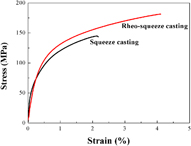Crossref Citations
This article has been cited by the following publications. This list is generated based on data provided by
Crossref.
Zhang, Yang
Li, Xiao-ping
Sun, Shun-ping
Lu, Ya-lin
and
Wu, Guo-hua
2017.
Microstructure evolution and mechanical properties of rheo-squeeze casting AZ91-Ca alloy during heat treatment.
China Foundry,
Vol. 14,
Issue. 6,
p.
485.
Wei, X.
Qi, L.
Ju, L.
Tian, W.
Hou, X.
and
Li, H.
2017.
Effect of holding pressure on densification and mechanical properties of Cf/Mg composites.
Materials Science and Technology,
Vol. 33,
Issue. 5,
p.
629.
Chen, Xingrui
Ning, Fangkun
Hou, Jian
Le, Qichi
and
Tang, Yan
2018.
Dual-frequency ultrasonic treatment on microstructure and mechanical properties of ZK60 magnesium alloy.
Ultrasonics Sonochemistry,
Vol. 40,
Issue. ,
p.
433.
Chen, Xiao-yang
Zhang, Yang
Lu, Ya-lin
and
Li, Xiao-ping
2018.
Microstructure and mechanical properties of AZ91-Ca magnesium alloy cast by different processes.
China Foundry,
Vol. 15,
Issue. 4,
p.
263.
Wang, Qiuping
Li, Lu
Zhou, Rongfeng
Li, Yongkun
Xiao, Fan
and
Jiang, Yehua
2019.
Rheological behavior of semisolid hypereutectic Al–Si alloys.
Journal of Materials Research,
Vol. 34,
Issue. 12,
p.
2105.
Huang, Xinsheng
Chino, Yasumasa
Ueda, Hironori
Inoue, Masashi
Kido, Futoshi
and
Matsumoto, Toshiharu
2019.
Improvement of mechanical properties of extruded AZX912 magnesium alloy using high-temperature solution treatment.
Journal of Materials Research,
Vol. 34,
Issue. 21,
p.
3725.
Chang, Zhiyu
Su, Ning
Wu, Yujuan
Lan, Qiao
Peng, Liming
and
Ding, Wenjiang
2020.
Semisolid rheoforming of magnesium alloys: A review.
Materials & Design,
Vol. 195,
Issue. ,
p.
108990.
Zhu, Yanli
Xu, Xiaolong
Zhao, Junwen
and
Hu, Guangzhong
2021.
Effect on microstructure and corrosion resistance of semi-solid slurry of 7A04 aluminum alloy by electromagnetic stirring.
Materials Research Express,
Vol. 8,
Issue. 1,
p.
016506.
XIAO, Ran
LIU, Wen-cai
WU, Guo-hua
ZHANG, Liang
LIU, Bao-liang
and
DING, Wen-jiang
2021.
Effect of Ca content and rheo-squeeze casting parameters on microstructure and mechanical properties of AZ91−1Ce−xCa alloys.
Transactions of Nonferrous Metals Society of China,
Vol. 31,
Issue. 6,
p.
1572.
SHABESTARI, Saeed G.
and
GHANIABADI, Ehsan
2023.
Effect of Ca and rotation speed on microstructure and solidification parameters of AZ91 magnesium alloy produced by semi-solid casting through rotating container process.
Transactions of Nonferrous Metals Society of China,
Vol. 33,
Issue. 2,
p.
396.
Najafi, Y.
and
Shabestari, S. G.
2023.
Investigation of the Effect of Inert Gas Bubbling Semi-Solid Process on the Microstructure and Mechanical Characteristics of AZ91 Magnesium Alloy.
JOM,
Vol. 75,
Issue. 9,
p.
3924.





